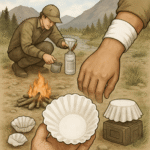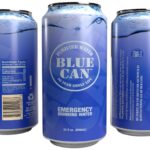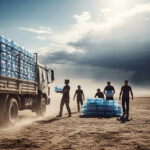Water is one of the most essential survival supplies to have stored away for any emergency situation, and by stockpiling enough for all family members hydration needs you can ensure they will always have enough to drink.
Food-grade plastic containers with blue hue are optimal for water storage as they limit light exposure and prevent algae growth.
1. Pre-packaged bottled water
One of the easiest and simplest ways to store water during an emergency is purchasing pre-packaged bottles of bottled water from retail outlets. These are made of food-grade plastic and sealed tightly for extra safety – plus, their portability makes them great additions in case of crisis situations.
Plastic water bottles may not be ideal when exposed to prolonged heat exposure; plastic can develop an unpleasant flavor and smell that taints its contents, while cheaper bottles tend to leak when heated – thus necessitating regular rotation of emergency supplies for maximum quality and effectiveness.
Food-grade water storage containers should always be used when storing water, like those available from outdoor supply stores and some major box retailers. These thicker bottles are designed to withstand leakage and contamination and made with HDPE plastic that does not leach harmful chemicals into the water, unlike some alternatives like PE plastic or PVC which do. HDPE is also widely used in making long-term tanks like 55 gallon tanks typically found at construction sites or farm supply stores.
As another option for emergency water storage, purchasing milk carton-type water jugs or large soda bottles may be useful; however, these are often biodegradable plastic that leak over time. A better option would be a waterBOB which can hold up to 100 gallons and fits easily into bathtub storage with pump out from faucet (if applicable) for pump out from storage as it won’t degrade as plastic would.
2. Water tanks or cisterns
A cistern is a large water storage tank used for collecting and storing rainwater for later use. They are generally constructed near where their rainwater will be used – such as houses or barns – though underground models can also be installed. They often come equipped with screens for filtering out debris as well as pumps that enable easy retrieval of the stored water, making cisterns particularly helpful in rural agricultural settings, backwoods camping grounds or locations without reliable water sources.
Plastic barrels, commonly referred to as “rain barrels,” are an efficient means of water storage. When connected to gutters, these large containers fill automatically when it rains; alternatively they can be manually filled from outside sources like lakes or rivers. Food-grade barrels with tap or spigot dispensing systems make dispensing water even simpler, while disinfection requires only adding one tablespoon of unscented liquid household bleach per gallon of water stored.
As always, water storage amounts depend on your family’s individual needs. A general guideline would be to store three days’ supply for every person living in your household to ensure everyone has enough to survive an emergency situation. Make sure that it is stored away from sunlight and heat sources as this can cause it to spoil over time; additionally it’s beneficial if containers made without BPA leech into your water, thus helping prevent potential health risks associated with leaching into it.
3. Containers
Water containers are an effective way of storing emergency supplies, from individual water bottles available at grocery stores, large IBC totes (used to transport liquids like gasoline and chemicals), or rain barrels (designed to collect rainfall from gutters, typically fitted with taps for easy use).
Water storage containers should be food-grade sterile containers made of nonporous material that does not absorb or leach chemicals into the water being stored. Plastic is ideal as it resists temperature changes and chemical exposure, although glass or stainless steel are also good choices. You could make your own by sterilizing jars before filling with clean water before sealing their lids securely – labeling each one accordingly with its contents, date, amount stored etc.
Calculating emergency water needs is another essential aspect to take into account. A general rule of thumb suggests having two weeks’ supply stored for each person in your household – this requires knowing how many gallons each will require per day during an emergency situation.
Water does not expire, but it’s wise to regularly replace and test stored supplies to ensure its safety for consumption. Over time, its quality can deteriorate as it absorbs impurities from containers or becomes polluted with bacteria or contaminants; for this reason it is advised that you filter your stored water as you store it.
4. Filters
Filters are an invaluable way of providing clean drinking water at home. Not only can it ensure that what you drink is safe, but it can be vital during an emergency situation. Filters are widely available across stores; even DIY kits exist that allow users to create their own.
Most filters utilize carbon or iodine filters to effectively eliminate bacteria and protozoa from water supplies, which may leave behind an unpleasant flavor in your drinking water that can be eliminated with taste neutralizer tablets. Furthermore, these filters can remove other contaminants, like lead that are present.
If your filter requires dry storage, be sure to follow its instructions for assembly and storage closely. This includes mixing a solution to sanitize it as well as using a cloth or dry towel to wipe down its interior surfaces. Alternatively, some filters may still be safe to use when stored wet; in such a situation it would be wise to store the water separately so as not to spread bacteria from other food or drinks sources into it.
Store rainwater for use around your home by collecting it during storms. This approach is simple to set up and costs next to nothing compared to alternative solutions such as purchasing packaged water from retailers, while its versatility ranges from washing clothes and flushing toilets all the way through to being used as drinking water. Keep in mind, however, that bacteria and other contaminants could enter through rainstorms so ideally only use treated rainwater as drinking water; and only store in clean containers in order to use quickly after storage.
5. Water sources
Water is an indispensable natural resource, yet much of it remains frozen within glaciers and polar ice caps. Only three percent of Earth’s freshwater supply is suitable for human consumption – making emergency preparedness of great importance; here are several strategies you can employ in storing your own supply.
When storing water, it’s essential that the right containers are used. Glass and stainless steel bottles are the optimal choices as plastic may leach chemicals that could be hazardous to human health; BPA-free plastic containers should also be selected if possible. 55 gallon drums can also be found at many hardware stores for industrial liquid storage needs.
Other containers for water storage can be plastic buckets, IBC totes (large industrial tanks) and rain barrels. Water barrels may come equipped with both spigot and taps for easier accessing of stored water, and should ideally be placed in cool, dark places where rotation and regular checks should occur – additionally having access to filters in case it becomes contaminated could also help.
Emergency preparedness experts suggest stockpiling one gallon per day per person as an adequate emergency water reserve, to cover basic needs like hydration and sanitation. However, this amount may not cover other essential tasks like cooking, cleaning and first aid – hot weather can require even more. Therefore, it is wise to store at least two weeks’ worth of water per family member – this should give enough security should an emergency situation arise.




